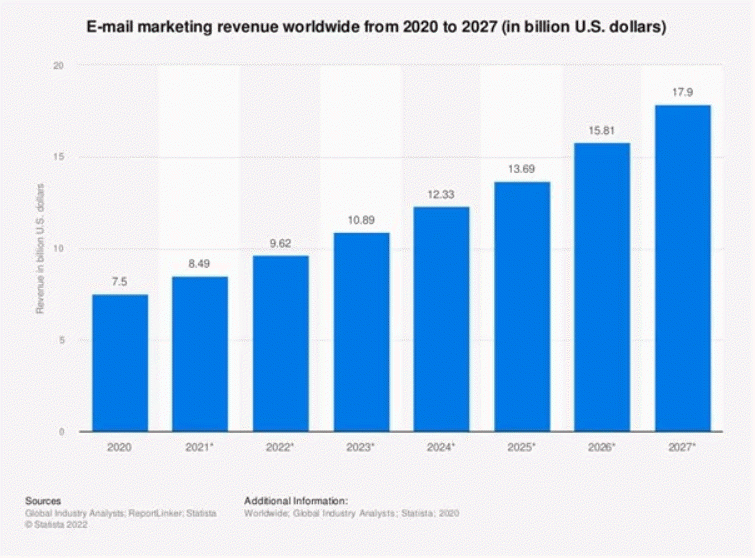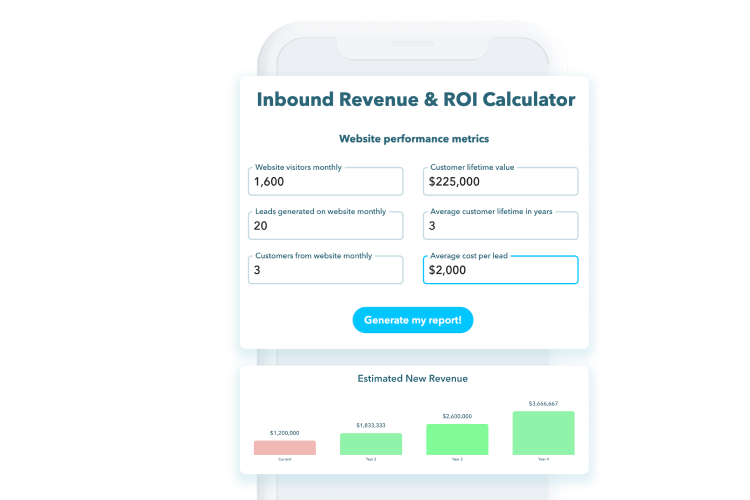 1,778 views
1,778 views 5513 Views
5513 Views  9 min read
9 min readEmail marketing lead generation can feel like a never-ending battle. Not only are you navigating savvy buyers and your top competitors, but you’re also dealing with a new buying environment and a ton of misinformation or misconceptions. There was a time (pre-pandemic) for B2B technology industry leaders to hit the road, stirring up new prospects and qualified leads through face-to-face interactions, taking customers or clients to events, and networking at conferences.
Post-pandemic, the same professional travels less but still faces the same quotas to hit. Today, over 70% of B2B decision-makers prefer remote human interactions or digital self-service. This new landscape leaves the best salespeople with a challenge. How will they find new customers whose problems they can solve when those same customers prefer a new way of doing business? B2B lead generation has become essential to fill the gap in their pipeline.
While email opt-in requirements and laws differ in the countries, privacy laws aim to protect consumers from receiving unwanted marketing communications. If you want more customers and close more B2B deals, businesses need to follow best practices before engaging in email marketing activities.
Opt-in rules in the U.S., EU, and Canada
One of the biggest misconceptions in email marketing is that the requirements and laws are the same globally. The laws primarily target spammers to prevent constant ‘spamming’ with unsolicited emails. The CAN-SPAM Act regulates email marketing in the U.S., which allows marketing email messages to be sent without permission until the recipient requests an ‘opt-out.’ Email messages must include an opt-out/unsubscribe option.
Canada and Europe are more stringent with their permissions. Email messages can only be sent to prospects who have previously consented and ‘opted-in’ to receive any messages. And even though there’s no requirement under GDPR to have a double opt-in process, some countries consider it a best practice.
The EU follows the General Data Protection Regulation (GDPR), which covers more regulations than the United States. GDPR regulates how organizations use and retain email addresses. Canada adheres to Canada’s Anti-Spam Legislation (CASL), which requires consent, identification information, and an unsubscribe method in each message.
If you’re a business that caters to businesses in the U.S., GREAT NEWS!!! email marketing may be more adaptable and an effective marketing practice you can implement swiftly. If you do engage in email marketing, you should always be aware of any changing laws that emerge to protect user privacy and curb spam. . .
Disclaimer: This article explores the legal requirements for email marketing in different countries but is for informational purposes only and not intended as legal advice.
Compared to traditional marketing efforts, email marketing is cost-effective.
 Source: Statista
Source: Statista
In addition, according to a McKinsey study, email is 40 times more effective at acquiring new customers than Facebook or Twitter. Probably because, as of January 2022, 92% of all US consumers still use email daily as a form of communication, and it’s projected to grow. Common marketing channels are email marketing and pay-per-click (PPC). PPC marketing has its advantages and disadvantages when compared to email.
PPC pros:
PPC cons:
Email pros:
Email cons:
Lead generation companies gather contact information for businesses that could be potential customers. With your target audience clearly defined, a provider will identify accurate contact information, which helps manage the lead generation strategy. Let’s look at what an email marketing lead generation process would entail . . .
Today, more high-quality, freshly verified contact data is available than ever before through providers like Zoom Info, Uplead, Lead411, RocketReach, Cognism, and more. They intend to help businesses connect with their dream prospects by providing premium contact and company information. Trustworthy list-building services deliver the highest quality data.
For example, Uplead has an 8-step verification process to ensure data validity. This allows you to build a highly targeted B2B list with real-time email verification. Accurate data and verified emails will help drive higher open rates. Providers like those mentioned help you find the best leads and close deals with less time wasted. You tailor your approach to the organization, industry, product/service, and audience. In order to perform at a higher success rate, it’s important to use the right email automation service with the capabilities you’ll need.
Email marketing automation saves time, boosts ROI, and delivers the best customer experience. Like contact data providers, there are different email marketing systems. Some popular ones are Mailchimp, Constant Contact, HubSpot, ActiveCampaign, SendGrid, and the list continues. It comes down to your needs and the service capabilities. Overall ease of use, functionality, affordability—cost per number of emails sent, deliverability, and reporting capabilities are considerations when choosing the exemplary email service.
Some services are more popular than others for ease of use with a full suite of digital marketing features. Others, like SendGrid, focus more on high-volume sending and email deliverability. It reports that its email deliverability peaks as high as 97%. Regardless of your choice, lead generation emails get you through the front door to your potential customers. Along with being able to send a large volume of emails, the right strategy and design also take precedence.
You can warm up your potential customers with the right strategy, design, and development. You can then identify the hot leads (ready to buy), the warmer leads (have an interest—they clicked on an email), or those that are not interested or just not ready to buy. Here’s the reality—even if your target audience is exposed to numerous touchpoints, they may not be ready to buy.
In fact, only 3% of your target audience will be ready to buy. Here’s the real breakdown of buyers in any market:
1. 3% of people are interested in buying ‘right now.’ (If their desire for your solution to their problem is strong enough.)
2. 7% of people are ‘open to considering a purchase.’ (They still need more information or experience with your brand to feel confident about their purchase.)
3. 30% of people are not thinking about it at the time.
4. 30% of people don’t ‘believe’ they are interested (based on the information they have at hand.)
5. 30% of people are definitely not interested. So 90% may not be ready now, but with consistent visibility in your email nurturing campaigns, when they are ready—they know it’s with your brand and the solution you offer.
We’ve found that by crafting thoughtful email campaigns focused on empathizing with client’s audiences, all while highlighting the strengths, benefits, and value a client’s solution offers their potential buyers, along with utilizing the latest email tracking technologies, we could help generate leads (mostly warm, occasionally hot.) We’ve experienced up to 9.8% click-thru rates for clients and 160+ leads generated in 1 day for a client.
Streamline your email design
Creating on-brand emails at scale takes much work.
Email teams need one centralized location to store and collaborate on shared resources, regardless their email service provider. A design library, like the one offered at Litmus, gives companies the place to create, store, manage, test, and collaborate on everything—including HTML email templates, code modules, brand colors, and more.
Testing your emails for better performance and deliverability is crucial for any email campaign. You want to ensure that the design elements are rendering correctly across all email clients, that the emails are accessible, and that any links in the email are working.
Broken emails lead to less conversion. However, if your emails are not working across various devices and email clients like the notorious Microsoft Outlook, your email campaigns are set up for failure. The best email client for your business depends on your company’s needs and capabilities. For example, if you look at Outlook and Gmail, they are powerful business email clients, but there are key differences between the two providers.
There are many ways to develop an email to send to your customers or potential customers—from drag-and-drop editors built into your email service provider (ESP), such as HubSpot, that sends email on behalf of its users through a shared network, to using free templates or creating your own HTML template from scratch. HTML email development requires coding and designing skills but gives you more freedom to the look and feel of the design. The tricky part here is that email clients render email differently. So what looks great on one looks horrible on another.
Testing your email is the only way to ensure you’re sending out the best email across email clients, devices, and the design is responsive (special coding that allows your email to display perfectly across different devices.) Using a software service like Litmus helps get high-quality email campaigns previewed and tweaked before sending to avoid coding mistakes, compatibility across email clients and improve overall quality of your campaign performance.
With email automation, your business can take advantage of opportunities to nurture and engage your target audience. Email automation uses a set of enrollment criteria to send personalized messages based on specific actions your customer takes. It is a tool that sends triggered emails based on their behavior, actions, and the buyer’s journey.
The most effective email campaigns are set up with automation software, targeted users through segmentation, proper template, workflow with time intervals and conditions (i.e., whether they opened, clicked an email, or submitted a form), and monitoring the campaign’s progress. Automation works perfectly when your message is relevant to the reader.
A significant advantage of email automation is identifying new leads quickly and efficiently. Instantaneous notifications sent to the sales team to act upon them increase B2B opportunities. A challenge with most sale funnels is keeping warm leads from growing cold without proper follow-up. With quick notifications, your sales team has a better chance to build a connection and educate your potential customers with the information they are searching for.
Want to boost your email marketing lead generation efforts?
Let’s recap the lead generation process as we know it is a process and a strategy that needs to be developed and nurtured just like your leads:
1. Find the contact information of potential buyers (using a reputable lead generation provider)
2. Select email automation software (depending on your needs—interested in other marketing features or just need a large volume of sends)
3. Identify who you’re sharing your campaigns with (the target audience for the offer you’re promoting, send to your ideal client profile)
4. Determine your email campaign goal (one goal/challenge per email)
5. Set enrollment criteria
6. Create your email asset
7. Run a test for your email automation
8. Monitor its progress
Also Read – Email Nurturing: What is It and How to Do It Successfully
If you haven’t considered email marketing for your business, now is the time (especially if you’re a B2B in the U.S. while privacy laws and requirements are not as stringent as in other countries.) Working with a trusted marketing consultant makes the process simple and cost-effective. With a strategic approach, proper guidance, and a strong message, your business is sure to benefit.
Also Read – How to Effectively Utilize Email Lead Generation
